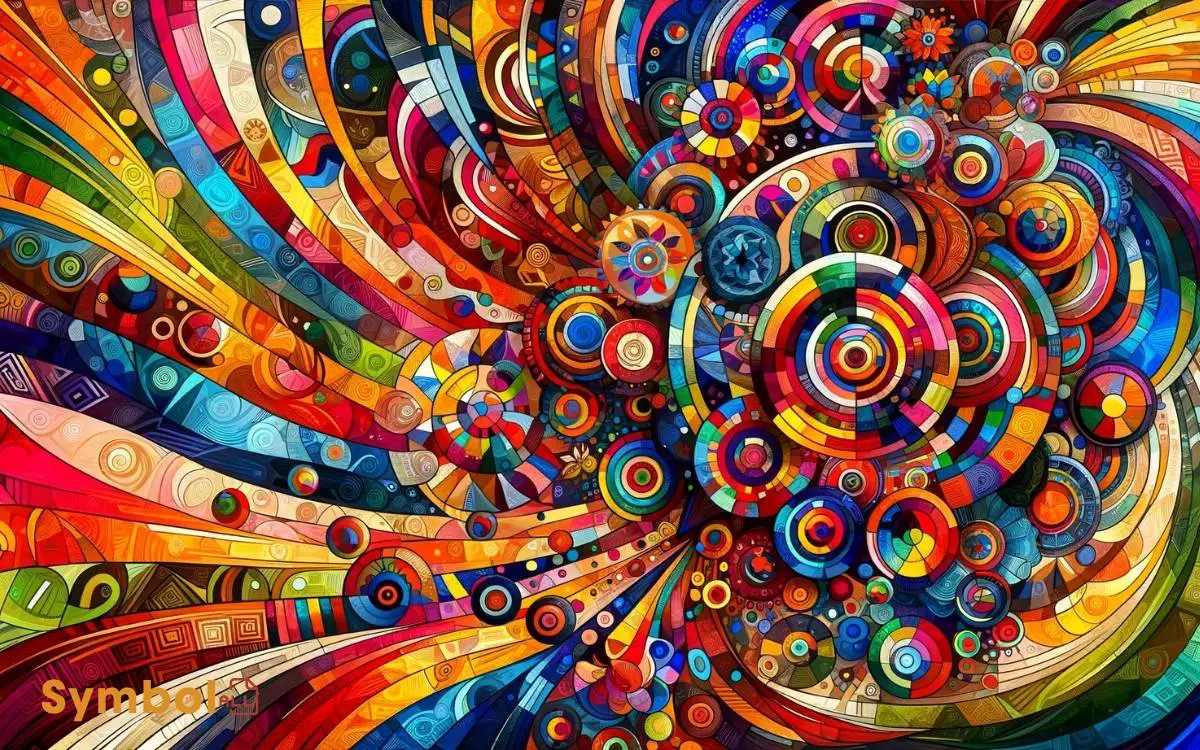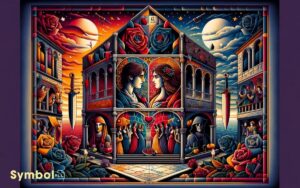Color Symbolism in Mexican Culture: Explains!
In Mexican culture, colors are more than just visual elements; they’re deeply intertwined with emotions, traditions, and the natural world.
- You’ll find red pulsating with energy and passion, central to celebrations that mark the community’s vibrancy.
- Blue, with its serene shades, mirrors the sky and sea, revealing stories and ancestral wisdom. Green speaks to the fertile lands, reflecting hope and Mexico’s connection to the earth.
- Yellow bursts in festivities, embodying joy and the sun’s historical significance.
Each color carries a unique narrative, from the tranquility of white to the warmth of orange, the spirituality of purple, and the earthiness of brown, encapsulating the essence of Mexican spirit and heritage. As you venture further, you’ll uncover more layers to these colorful expressions.

Key Takeaways
10 Color Symbolism and Meaning in Mexican Culture
| Color | Symbolism in Mexican Culture |
|---|---|
| Red | Represents the blood of national heroes, struggle, and revolution. It is also associated with life and vitality. |
| Green | Symbolizes independence, hope, and the beauty of vegetation. It is also a color of good luck and health. |
| White | Stands for purity, peace, and unity. It is the color of spirituality and is often used in religious contexts. |
| Black | Associated with death, the underworld, and mourning. It is also a color of elegance and formality. |
| Yellow | Linked to the sun and maize, a staple in Mexican cuisine. It can also signify mourning or disease in some contexts. |
| Blue | Reflects trust, loyalty, and wisdom. It is also connected to the sky and the Virgin Mary. |
| Pink | Often used in celebrations and represents the joy, playfulness, and the charm of Mexican festivals. |
| Purple | Symbolic of mourning during Holy Week, it also signifies wealth, royalty, and authority. |
| Gold | Indicates power, success, and achievement. This color is often found in Mexican crafts and artwork. |
| Brown | Represents the earth and is associated with stability and strength, reflecting the resilience of Mexican culture. |
The Vibrancy of Red
Red, symbolizing passion and energy, plays a pivotal role in Mexican culture, embodying the heart of its vibrant traditions and celebrations.
You’ll find its presence in the rich tapestries that adorn homes and streets during festivals, a visual confirmation to the community’s spirit and resilience.
In culinary traditions, red isn’t just a color but a flavor. It represents the heat of chili peppers that dance on your palate, igniting a love for life with every bite.
This color also weaves its way into the national identity, seen in the Mexican flag, where it stands for the blood of national heroes.
Through an analytical lens, red’s significance in Mexico isn’t just about the hue; it’s a profound expression of the nation’s fiery heart and soul, deeply ingrained in its social fabric and daily life.
Exploring the Depths of Blue
Just as red captures the fiery spirit of Mexican culture, blue reveals its profound depth and serenity, embodying the sky and sea that surround and shape this vibrant land.
This color, rich in symbolism, offers a window into the soulful and introspective aspects of Mexican heritage.
| Shade of Blue | Symbolism | Context in Mexican Culture |
|---|---|---|
| Cobalt Blue | Wisdom | Used in art to represent depth of thought |
| Sky Blue | Tranquility | Evokes the peacefulness of clear skies |
| Navy Blue | Authority | Often found in traditional clothing, symbolizing strength |
| Turquoise | Healing | Associated with protection and healing in jewelry |
Each hue of blue carries its own story, deeply woven into the fabric of Mexico’s cultural identity, reflecting its people’s connection to the natural world and their ancestral wisdom.
The Lushness of Green
Why does the color green, with its numerous shades, evoke such a deep sense of energy and rejuvenation in Mexican culture?
You’ll find green everywhere, symbolizing the rich vegetation and the fertile lands that are integral to Mexico’s identity. This color isn’t just a representation of the natural landscape; it’s woven into the fabric of daily life, manifesting in art, cuisine, and national symbols.
It conveys a message of hope and prosperity, reflecting the resilient spirit of the Mexican people. In celebrations and traditional attire, green stands out, embodying the connection to the earth and the ancestors who cultivated it.
This color’s vibrancy is an affirmation to Mexico’s enduring love for life, encapsulating a blend of history, nature, and cultural pride.
A Journey Through Yellow
As you explore the vibrant hues that paint Mexican culture, you’ll find that yellow holds a special place, rooted deeply in the country’s history and traditions.
Yellow’s historical roots intertwine with indigenous beliefs and the Spanish conquest, creating a rich tapestry of meaning that spans centuries.
In festivities, this color bursts forth, symbolizing joy and prosperity, and weaving itself into the fabric of Mexican celebrations with undeniable vibrancy.
Yellows Historical Roots
Delving into the vibrant history of yellow in Mexican culture reveals its profound significance, rooted in ancient traditions and beliefs. This color, embodying the warmth of the sun, has historically symbolized strength, growth, and fertility.
Ancient civilizations, such as the Maya and the Aztecs, revered yellow for its association with corn, a staple and sacred crop, marking it as a symbol of sustenance and life.
Yellow’s connection to the sun positioned it as a divine color, central to rituals aimed at ensuring abundant harvests and balance in the natural world.
As you explore its historical roots, you’ll find yellow’s presence in art, pottery, and textiles, each piece a confirmation of its enduring legacy and the cultural value it holds.
Yellow in Festivities
Frequently, yellow lights up Mexican festivities, symbolizing joy and prosperity against the backdrop of deeply rooted traditions.
You’ll find this vibrant hue in marigold flowers adorning altars and pathways during Día de los Muertos, a celebration that honors the deceased with a fusion of indigenous and Christian beliefs.
The yellow petals are believed to guide the spirits back to the living world, showcasing a blend of reverence and celebration unique to Mexican culture.
In addition to spiritual gatherings, yellow permeates secular events, manifesting in decorations, clothing, and culinary presentations. Its presence isn’t just aesthetic; it’s a deliberate choice reflecting an enduring optimism and a wish for good fortune.
Through each use, yellow weaves a narrative of resilience, community, and the enduring pursuit of happiness in Mexican festivities.
The Tranquility of White
In Mexican culture, white isn’t just a color; it’s a symbol of peace and purity interwoven into the fabric of traditions and ceremonies.
It stands as a proof to tranquility, especially evident in the serene ambiance of weddings and religious events.
This color’s ability to embody both peace and purity elevates its significance, making it an essential part of Mexican cultural expressions.
Peaceful Ceremonies Significance
White, symbolizing purity and peace, plays a central role in Mexican ceremonies, enveloping these occasions in an aura of tranquility and harmony.
You’ll find this color dominating peaceful ceremonies, such as weddings and baptisms, where it sets a serene backdrop, encouraging a collective focus on the event‘s significance.
In these settings, white isn’t merely a choice of decoration; it’s a deliberate invocation of peace and new beginnings. It’s as if the color itself casts a silent spell, urging attendees to reflect on the purity of the moment.
This usage of white transcends mere aesthetic appeal, embedding itself deeply in the cultural consciousness as a harbinger of peace.
Through this color, ceremonies become more than rituals; they transform into profound experiences, fostering communal bonds and emphasizing the shared values at the heart of Mexican culture.
Purity in Traditions
Building on the significance of white in peaceful ceremonies, it’s also deeply woven into the fabric of Mexican traditions, embodying purity and serenity across various cultural practices.
You’ll find white prominently featured in religious events, particularly in baptism and wedding attire, signifying a fresh start and inherent purity.
Its use isn’t limited to clothing; white decorations and candles are prevalent in ceremonies, symbolizing light and purity guiding one’s path.
This color’s tranquility extends to the Day of the Dead celebrations, where white flowers, especially marigolds, purify and welcome spirits back to the earthly domain.
Analyzing these traditions, you grasp how white transcends mere color, becoming a beacon of purity, peace, and renewal within the rich tapestry of Mexican cultural practices.
The Mystery of Black
Many people don’t realize that black plays a complex and deeply symbolic role in Mexican culture, embodying both the solemnity of death and the richness of the unknown.
You’ll find its presence in various aspects, from the elegant attire at traditional celebrations to the intricate designs in local art.
Black isn’t merely a color of mourning; it’s a hue that invites introspection and respect for the cycles of life. In the Day of the Dead festivities, for instance, black accents on altars and costumes honor the deceased, creating a bridge between the living and the spirits.
This contrast isn’t just visual; it’s a profound statement on the interconnectedness of life’s joys and sorrows, highlighting a community’s embrace of life’s full spectrum.
The Warmth of Orange
As you explore the vibrant tapestry of Mexican culture, you’ll find that orange isn’t just a hue; it’s a celebration of life and change.
This color, rich in symbolic meanings, often adorns festivals and ceremonies, encapsulating joy, warmth, and creativity.
It’s a proof of how Mexicans embrace the full spectrum of life’s experiences, from the earthly to the spiritual.
Orange in Celebrations
In Mexican celebrations, the color orange bursts onto the scene, symbolizing warmth and joy, and inviting participants into a vibrant atmosphere of festivity and community. This hue, with its vital and essential essence, plays a pivotal role in setting the tone for numerous events.
From the marigold flowers adorning altars during Día de los Muertos to the lively decorations at local festivals, orange weaves itself into the fabric of Mexican culture, evoking feelings of happiness and sociability.
It’s not just a color; it’s a medium through which stories and traditions are told, bridging the gap between the past and present.
As you immerse yourself in these celebrations, you’ll find that orange isn’t merely a visual delight it’s a heartfelt invitation to connect and participate in age-old traditions.
Symbolic Orange Meanings
The warmth of orange in Mexican culture embodies more than just a visual appeal; it carries deep symbolic meanings of enthusiasm, creativity, and endurance.
This vibrant hue permeates various aspects of life, encapsulating a zest for living that’s deeply ingrained in the Mexican spirit.
It’s not merely a color; it’s a confirmation to the resilience and vibrant creativity that define the culture. When you see orange in Mexican art or festivals, you’re witnessing a celebration of life‘s infinite possibilities and a homage to the enduring spirit of the people.
This color’s significance is deeply contextual, blending historical influences with contemporary expressions of joy and innovation. It’s a reminder that, in Mexican culture, the most ordinary elements can hold extraordinary meaning.
The Richness of Purple
Purple’s vibrancy and depth hold significant cultural and symbolic weight in Mexican tradition, embodying spirituality, mourning, and celebration.
This rich hue, often seen in traditional textiles and religious garments, serves as a bridge between the physical and spiritual worlds.
In ceremonies like the Day of the Dead, purple plays an essential role, representing mourning and remembrance for lost loved ones. Yet, it also celebrates life’s continuity beyond death, highlighting the cyclical nature of existence.
In Mexican culture, purple isn’t just a color; it’s an experience, woven into the fabric of daily life and festivity.
It invites you to explore deeper into the spiritual aspects of existence, encouraging a profound appreciation for the unseen forces that shape our lives and traditions.
The Earthiness of Brown
Brown, a color deeply rooted in Mexican culture, symbolizes the nation’s rich earth and enduring strength, offering a foundation from which traditions and daily life emerge.
You’ll notice its presence in the pottery, textiles, and even the adobe bricks used in building, each shade telling a story of connection to the land.
This color isn’t just a backdrop; it’s a narrative of resilience, of a people’s ability to harness the earth’s resources.
In ceremonies and daily wear, brown embodies a respect for the natural world, reminding us of the cycle of life and the importance of grounding oneself in heritage.
It’s a tribute to Mexico’s history, an homage to the soil that sustains and defines a culture.
The Significance of Pink
Vibrant and deeply symbolic, pink captures your imagination, representing celebrations, femininity, and the fight for social causes within Mexican culture. It’s a color that you’ll see adorning streets during festivals, symbolizing joy and the vibrancy of life.
Concerning femininity, pink reflects the nurturing and compassionate aspects, often associated with the traditional roles women play in society. Yet, it’s also a color of strength, worn in campaigns and marches advocating for women’s rights and against gender-based violence.
This dual symbolism shows how pink’s meaning in Mexico is layered, blending joy with resilience. It’s more than just a hue; it’s a narrative of celebration, struggle, and empowerment, deeply woven into the fabric of Mexican societal values.
The Role of Silver and Gold
In Mexican culture, silver and gold aren’t just precious metals; they embody a rich tapestry of history and significance, reflecting the nation’s complex relationship with its natural resources and colonial past.
Silver, often associated with the moon, purity, and renewal, has been mined in Mexico since ancient times, playing a pivotal role in its economic development and global trade.
Gold, symbolizing the sun, spirituality, and power, connects deeply with pre-Columbian civilizations, highlighting their advanced metallurgical skills and the Spanish conquest’s devastating impact.
Together, these metals represent a duality of Mexico’s identity—its indigenous roots and colonial influences woven into the fabric of its culture, art, and religious practices, reminding you of the country’s resilience and rich heritage.
Conclusion
As you’ve journeyed through the vibrant tapestry of colors in Mexican culture, you’ve uncovered not just the aesthetic appeal but the deep-seated meanings each hue holds.
From the passionate embrace of red to the serene whispers of white, every color tells a story, rooted in history yet alive in contemporary celebration.
It’s a chromatic symphony where the past and present dance in harmony, painting a society rich in tradition and bursting with life.
In this palette, every shade is a word, every hue a narrative, weaving the fabric of Mexican identity with threads of timeless significance.






